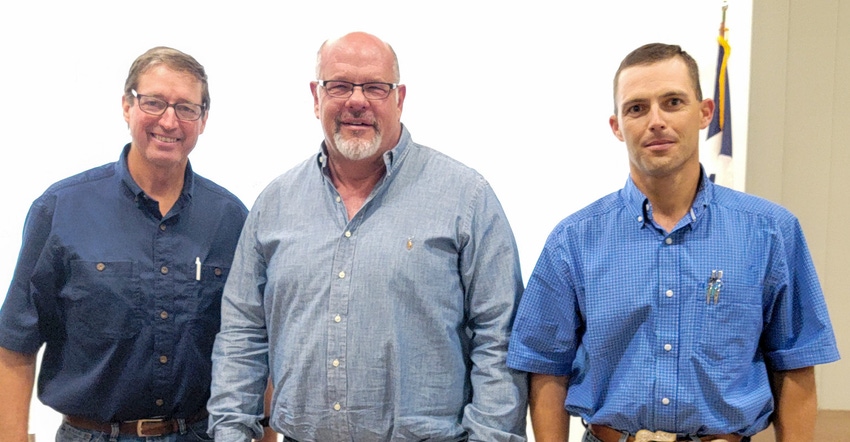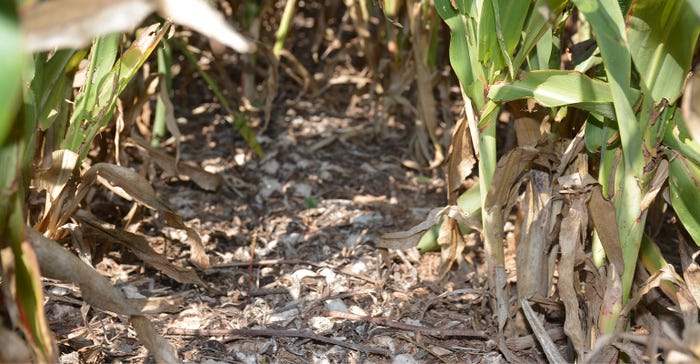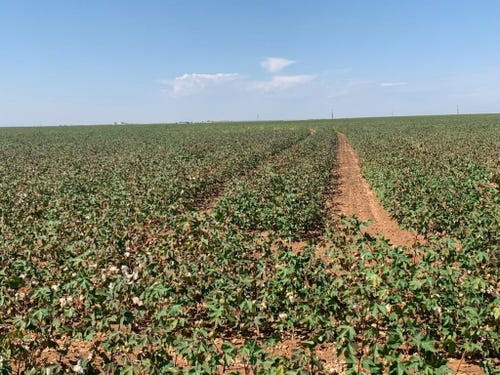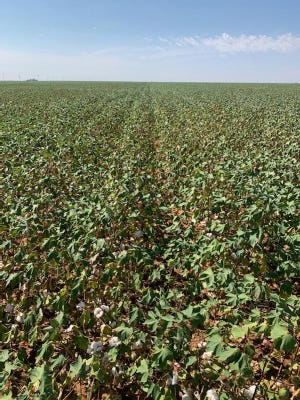
Three Texas producers confess it's taken a lot of failure mixed with success to make reduced tillage and/or cover crops a successful management system on their farms.
Martin County producer Josh Tunnell recently joined Swisher County farmer Barry Evans and Hale County producer Steve Olson in a grower panel at the Texas Alliance for Water Conservation Field Day. The three discussed the use of conservation tillage in their dryland and irrigated fields.
They all agreed, it's not a one-size fits all system.
Barry Evans, Swisher County
Evans converted to no-till 25 years ago. Initially, part of his motivation was to reduce wind damage to his crops. But a greater concern for him was the moisture lost every time he ran a plow. And in an area with limited rainfall and a nonreplenishing aquifer, that's not something he could afford to lose.
"Several years ago, after I drilled a couple of wells, they both pumped about 60 gallons per minute. I thought, those wells will never ever be any better than they are today. In about 5 years, they're going to be about 30 gallons per minute and in about 10 years, I'm going to be out."
 Barry Evans rotates no-till, cotton and grain sorghum. He says following grain sorghum with cotton makes his cotton better. (Photo by Shelley E. Huguley)
Barry Evans rotates no-till, cotton and grain sorghum. He says following grain sorghum with cotton makes his cotton better. (Photo by Shelley E. Huguley)
He decided then to quit chasing the water. "I needed to get by with what I had." But he also knew it would be necessary to farm without it, "because in the future, we're all going to be dryland farmers," he said.
Evans, along with Olson, irrigate out of the Ogallala Aquifer. "When I pump an acre inch of water now, it's gone. It's never coming back," he said. "If I waste money, I can go out and make some more money, but if I pump that water out, it's gone."
He began to ask himself, "How can I get the most dollars per acre inch out of that water?" He centers his thinking on dollars per acre inch of income. "That's one reason I don't chase big yields. There's your theory of diminishing returns and there's a point where you start putting out more water and less dollars or pounds, however you want to figure it, per acre inch."
Crop rotation is key to his production plan. For the last 25 years, he's rotated cotton and grain sorghum. "I do my irrigated and dryland just alike. I don't try to change anything up because I know that it's all going to be dryland before for long." A wheat-cotton rotation has also worked well, he added.
One question he is often asked is if cotton makes the most money, why grow grain sorghum or wheat? Because it makes his cotton better, he said.
"If you can increase your cotton yields consistently and if you're lucky, you can get a 15% to 20% increase over time on the rotation, you'll actually net more dollars. You won't gross more dollars, but you'll net more money and to be sustainable, that's a part of the deal, too."
Cover crops remain a point of contention for him. "I've played with them, but I have not figured it out. I've seen some of the data that says we replenish our moisture with a cover crop, and that might be true, but I have not been able to make it work. I'm still trying."
Steve Olson, Hale County
In Hale County, Olson, who admitted he's probably failed more than anybody in the room, went from conventional tillage to no-till only to return to tillage. "We struggled with weed control because our soil wasn't ready for no-till," he said.
Then he learned about strip-till. "I visited with our local Orthman dealer at the time and told him I wanted one of those planters. He said, 'That won't work here. Our soils just aren’t right for it.' So, I went to the Oklahoma Panhandle and bought a two-year-old strip-till machine and low-and-behold it did work.
 Crop rotation, including these sunflowers, is a big part of Steve Olson's production management system. (Photo by Shelley E. Huguley)
Crop rotation, including these sunflowers, is a big part of Steve Olson's production management system. (Photo by Shelley E. Huguley)
"What we found later was if we would go in and put our fertilizer at two different depths, probably 70% down low, usually about 8 inches, 30% about 4 inches above that, as those roots hit it, the roots will get exactly what they need and be incredibly prolific. If you'll take care of what's below the ground, it will take care of what's above the ground," he said.
Olson soil probes every field. "If we feel like we're ok not to plow, we don't plow." This year he no-tilled about 60% of his acres.
One thing that bothers Olson is how religious people can be about tillage practices. "They feel like if you do plow, you're destroying the soil. My message is be smart about what you do and don't let yourself get backed into a corner that makes you make decisions that aren't really good for your land."
Crop rotation is also instrumental. This year he's planted seed milo, regular milo, sunflowers, corn and wheat. He said the more species he rotates, the better and it's not a one-year deal, he added. "If you get your soil healthy and ready for the cotton stalk, then the cotton is able to kind of get on cruise control and roll through, and that's where it starts to pay off."
Josh Tunnell, Martin County
Tunnell farms 6,000 acres with his father near Stanton. All but 250 of their acres are dryland. "We've been playing with the cover crops and some different rotations for probably the last eight or 10 years," Tunnell said. "I've failed at it way more often than I've succeeded."
Tunnell said there are many young growers, including himself, trying them this year. "Some of it looks really good and there's other parts of it that there's no doubt it's a fail. In the past six years, I've had two years where my strip-till actually made a cotton crop."
He said many producers see cover crops as an antidote to sand fighting. "Well, that's a wonderful thing if you can get your cover crop established in time and get it killed where it has enough cover to where it holds the soil.
"We're discovering it's not a fit for every acre, but it does have its place."
 Skip-row, dryland cotton on Josh Tunnell's farm. This field was conventionally tilled. The drought prevented Tunnell from establishing a cover. (Photo by Josh Tunnell)
Skip-row, dryland cotton on Josh Tunnell's farm. This field was conventionally tilled. The drought prevented Tunnell from establishing a cover. (Photo by Josh Tunnell)
Tunnell primarily plants small grains for cover. "I've used triticale and wheat. We're still tweaking our operation and what we've discovered works better than trying to plant a small grain in the winter and then turn around and plant cotton behind it is to do more of a rotation."
This year, he's planting about third of his acres into small grains. "We've tried to take small grains on dryland area to harvest for the grain but it's hard to make that pencil out. But we're going to try to just hay that wheat next spring. And then I may leave a lot of those acres fallow until the next spring and plant cotton, where I'm not trying to grow two crops on all my winter moisture."
Before planting a cover crop, Tunnell warned producers to be aware of residual herbicide activity. "One of the big things with trying to plant wheat in late fall, a lot of the things you utilize in cotton production can be detrimental to establishing the cover crop in the fall if there's any residual in the soil. You have to pay attention to what you're using and what those effects will be."
Tunnell farms in sandy loam and deep sand soils. To prevent and treat weeds in his cotton, he uses Caparol or other residuals. "With resistant weeds, we've gone back to using more of those chemicals that they would tell you to stay away from in sandier soils. We've played with the rates enough that we found some usage for either banding those chemicals or waiting until your cotton gets up where you can plan it and spray underneath the crop that will allow it to work.
 Josh Tunnell's irrigated cotton planted into wheat cover. (Photo by Josh Tunnell)
Josh Tunnell's irrigated cotton planted into wheat cover. (Photo by Josh Tunnell)
"If you do it early enough in the year, we've figured out that even though our rainfall is somewhere between 13 and 16 inches, we still get enough that those will dissipate fast enough that you can late-fall plant some kind of cover and still get a good stand established."
Tunnell advises growers to first make a plan and then visit with other producers who have tried cover crops. "That's where I've gotten the vast majority of my information and from talking to our NRCS office, finding those producers who can say, 'We've tried this, and this is what we've run into.' It might keep you from making the same mistakes we did."
About the Author(s)
You May Also Like






